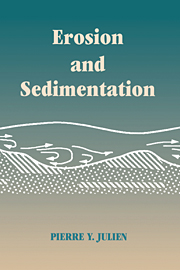Book contents
- Frontmatter
- Contents
- Preface
- Notation
- 1 Introduction to erosion and sedimentation
- 2 Physical properties and dimensional analysis
- 3 Mechanics of sediment-laden flows
- 4 Particle motion in inviscid fluids
- 5 Particle motion in Newtonian fluids
- 6 Turbulent velocity profiles
- 7 Incipient motion
- 8 Bedforms
- 9 Bedload
- 10 Suspended load
- 11 Total load
- 12 Reservoir sedimentation
- Appendix: Einstein's sediment transport method
- Bibliography
- Index
4 - Particle motion in inviscid fluids
Published online by Cambridge University Press: 05 June 2012
- Frontmatter
- Contents
- Preface
- Notation
- 1 Introduction to erosion and sedimentation
- 2 Physical properties and dimensional analysis
- 3 Mechanics of sediment-laden flows
- 4 Particle motion in inviscid fluids
- 5 Particle motion in Newtonian fluids
- 6 Turbulent velocity profiles
- 7 Incipient motion
- 8 Bedforms
- 9 Bedload
- 10 Suspended load
- 11 Total load
- 12 Reservoir sedimentation
- Appendix: Einstein's sediment transport method
- Bibliography
- Index
Summary
The analysis of particle motion in inviscid fluids is important because at large particle Reynolds numbers the flow of a viscous fluid around a particle may be regarded as consisting of two regions: (1) a thin layer called the boundary layer adjacent to the body, in which the viscous effects are dominant; and (2) the surrounding fluid, where the viscous effects are negligible. In this outer region the flow of a viscous fluid is essentially that of an ideal fluid and the pressure is transmitted to the boundary through the boundary layer.
The flow of inviscid fluids around submerged particles may be due to either the movement of the fluid or the movement of the particle or a combination of both. The following discussion considers flow conditions made steady by application of the principle of relative motion of the particle with respect to the surrounding fluid. The analysis focuses on simple particle shapes, such as cylinders (Section 4.1) and spheres (Section 4.2), to illustrate the fundamentals with simple calculations.
At every point on the surface of a submerged particle, the fluid exerts a force per unit area or stress. In Chapter 3, the stress vector was divided into a pressure component acting in a direction normal to the surface and two orthogonal shear stress components acting in the plane tangent to the surface. In this chapter, the stress vector for inviscid fluids is always normal to the surface, which means that there is only a pressure component and no shear stress.
- Type
- Chapter
- Information
- Erosion and Sedimentation , pp. 50 - 63Publisher: Cambridge University PressPrint publication year: 1995



